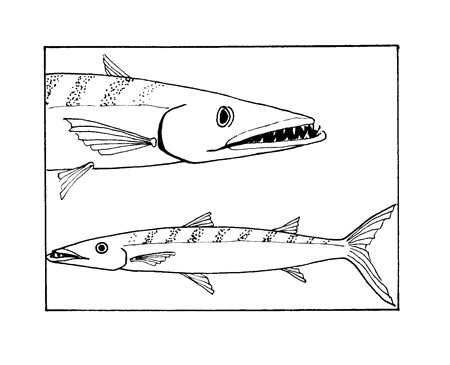Torpedoes of the Sea

For the last nine months, Laguna Beach and much of Southern California has been experiencing higher than normal water temperatures. Associated with this warm water event, El Niño, is the appearance of some marine visitors that are usually found in tropical and subtropical waters. The Pacific barracuda also called the California barracuda (Sphyraena argentea) is one such visitor. Traveling north in late spring and south in autumn, although they have been found in the Gulf of Alaska, they more typically migrate between Baja California, Mexico, and Point Conception, Calif. Found coastally around reefs and kelp beds in small, tightly packed schools, they have been found as deep as 120 feet.

Thought to live an average of 11 years, Pacific barracudas can reach a maximum of four feet in length and have slender, streamlined shiny-silver bodies with faint black bars along their backs. Their long pointed mouths have a distinct under bite and their teeth are large and sharp. Having a forked tail fin that is yellow in color, they have two dorsal fins that are widely spaced on top their body. The barracuda becomes sexually mature at around 2 years for males and 3 years for females. Like many other marine animals, the older and larger the female, the more eggs she produces. At her peak, at around 6 years, she can produce more than 400,000 eggs. During the summer months, females release their eggs into the water column where they are externally fertilized. Young barracuda tend to school fairly close to shore within the kelp beds.
Carnivores that feed primarily on small bony fishes, they are aggressive hunters that use their acute eyesight to find their prey. Moving slowly in tight schools, upon sighting the reflection or movement of a target, they explode rapidly to attack with their powerful jaws. They appear to be cooperative hunters that herd prey towards shallow waters to increase feeding success. Although marine mammals such as seals and sea lions have been known to feed opportunistically on injured and vulnerable barracudas, the primary predators of the California barracuda are thought to be giant sea bass, sharks and birds such as bald eagles.
After large population declines prior to the 1970s from sport and commercial fishing, the current numbers appear to be relatively stable. In Laguna Beach, schools of juvenile barracuda can often be found by swimming far out to the kelp beds just beyond the reefs in about 20 feet of water. When a school is approached too closely, it will typically turn as a unit and dart away.
Residents and year-round ocean swimmers, Mia Davidson and Jan Sattler are trying to foster environmentally responsible stewardship of our local ocean resources.




